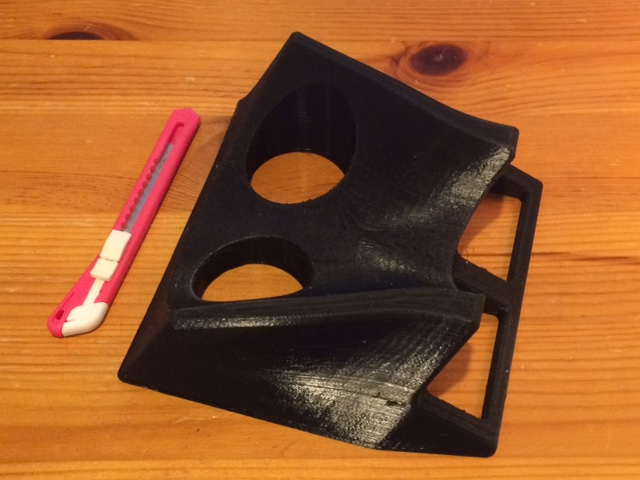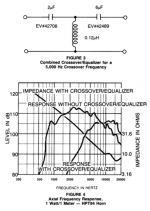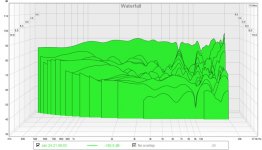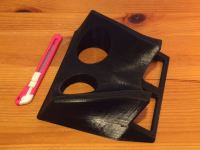3.5 hrs left to go. This is the biggest part I have ever made - pretty cool to see it grow.
Bushmeister: that is interesting why the second woofer changes the phase behavior. Perhaps an asymmetric injection allows the air flow to travel in a different path - farther across the horn rather than turning 90 deg in the middle due to symmetry. This extra bit of time delay is enough to compensate for that 55 deg bump at XO frequency? Maybe injection holes should not be diametric? Like they should be triangular or pentagonal symmetry?
Bushmeister: that is interesting why the second woofer changes the phase behavior. Perhaps an asymmetric injection allows the air flow to travel in a different path - farther across the horn rather than turning 90 deg in the middle due to symmetry. This extra bit of time delay is enough to compensate for that 55 deg bump at XO frequency? Maybe injection holes should not be diametric? Like they should be triangular or pentagonal symmetry?
Last edited:
What I see is the use of digital correction of the horn, just this is what I try to do not, and use analog ways, that is why things take time also.
I have also a lot of other work but I go on in spare time.
nice threat of a small nice horn.
I have also a lot of other work but I go on in spare time.
nice threat of a small nice horn.
What I see is the use of digital correction of the horn, just this is what I try to do not, and use analog ways, that is why things take time also.
I have also a lot of other work but I go on in spare time.
nice threat of a small nice horn.
But how do you prevent the use of digital means without cutting the grooves in the vinyl yourself these days? 🙂D just kidding here)
There is definitely something to be said for that approach. Especially if everything you play is analog as well.
But how do you prevent the use of digital means without cutting the grooves in the vinyl yourself these days? 🙂D just kidding here)
There is definitely something to be said for that approach. Especially if everything you play is analog as well.
No I do use cd, or dvd most is 96 bit. I use hybrid analog amp, and filtering (own discrete way of opamps) there is enough on the internet no need invent the wheel again.
CD is very good these days, and as long it is small signal path oke, but after the amp I need analog filtering, a horn in a horn is maybe very nice.
but the vinyl is busy with a come back, not because of it sound nice but it also put some old memories in mind by the people, that is why I love old cars and houses, it has memories people can feel, like me a HSPer.
HSP is not nice close with masts like gsm.
back ontopic now.
I have been listening to my horn for an extended period over past couple of days with the RS225 separate woofer. It sounds VERY good to me - in fact, one of the best sounding speakers that I have built so far. The waveguide's controlled directivity is especially noticeable at 3 meters away where the vocal clarity and loudness is almost as good as sitting 0.5m away due to reduced reflections. Really enjoying it and expect that once integrates with bass injection woofers will be an outstanding speaker. The fact that a COTS WG can be purchased solves the very tricky part of obtaining a great clean and smooth polar pattern that a large company invested much R&D into. It seems asking a lowly 84dB sensitive 2.5in fullrange driver to handle the duties from 500Hz on up is no problem. I can hear all the upper registers such as cymbals, high hats, bells, etc. without issue. As many can see who are following this thread, the construction is much simplified from making a traditional synergy as there are no mid-taps to deal with, and even as a 2-way, we can see from Bushmeister that with his amazing SB23's, he can cover 30Hz to 20kHz (don't ask me how). So the XO is simplified, and the fact that a single fullrange covers the telephone band permits excellent flat phase. And with use of a Harsch XO, the phase appears to be flat well down into 100Hz and below. A lot of advantages and really no disadvantage if you don't need pro sound SPL levels. 110dB to 116dB (depending on woofer) is still not too shabby though.
You need DSP to do this without breaking a sweat on the XO and EQ though.
Kees: I applaud your perseverence to sticking with analog, but miniDSP makes is oh so easy... Give the dark side a try sometime 🙂
You need DSP to do this without breaking a sweat on the XO and EQ though.
Kees: I applaud your perseverence to sticking with analog, but miniDSP makes is oh so easy... Give the dark side a try sometime 🙂
Last edited:
Kees: I applaud your perseverence to sticking with analog, but miniDSP makes is oh so easy... 🙂 Give the dark side a try sometime 🙂
X If I go on copying I do not learn, you have listen now to a dsp corrected horn, but also listen to one without?, I now the speaker itselfs is corrected and the horn sees a corrected speaker, so it is very forgiven, but when I listen to a dsp corrected bas box it is a other story.
I have did test H frames and open baffles, later on also dipoles (like it) and was all analog corrected, but on the other hand, I did now hear a dsp well, so need to buy one some day.
https://www.youtube.com/watch?v=DFVxB7Ff-iI
This video is made with a new hybrid who have null comma null feedback, only plate followers.
regards
It sounds terrible without DSP EQ - I suppose one could try to apply all that EQ passively and it is possible as you have shown that a simple 6uF capacitor HPF flattened the response of the Trynergy. It may be worth a trying a hybrid where a simple cap is used to take care of the predominant HF falloff and flatten the response, but then if you have DSP why bother because the cap adds a reactive system to the amp trying to drive it?
I have no dsp, I try to go analog, so need a filter for it, or with a K-tube what I now try a normal crossover.
My amp is such a beast it can even drive everything, complete stable with what filter ever, even short ciruit
but then it switch itself of.
but I go back to other threat these is a different one.
My amp is such a beast it can even drive everything, complete stable with what filter ever, even short ciruit
but then it switch itself of.
but I go back to other threat these is a different one.
Last edited:
I have no dsp, I try to go analog, so need a filter for it, or with a K-tube what I now try a normal crossover.
but I go back to other threat these is a different one.
We are in the same country, if you ever want to visit the dark side 😉. No horns here though, but I do have some passive components...
How can you pass up an invite to listen to Wesayso's Twin Towers??? 😀
You go Wesasyo - make a believer in the dark side out of Kees!
You go Wesasyo - make a believer in the dark side out of Kees!
Yes, the difference in phase immediately caught my eye too. Would love to see another early waterfall with the same settings as before. Just to see if there is indeed a change.
Soon as I get back home - I will oblige!
How can you pass up an invite to listen to Wesayso's Twin Towers??? 😀
You go Wesasyo - make a believer in the dark side out of Kees!
Ik wil, however I have no transtportation because working on my oldtimer car, and busy with mucho other things, I live 6 km from the efteling for clearance.
Dark side, hmm, I go watch starwars this evening.
Hey, It's possible to go half-Jedi/half Sith : FIR correction : phase+curve in the digital domain before your D/A conversion à la pos member with RePhase soft.
I'm looking for a distro à la Volumio/Moode/RuneAudio but with BruteFir in it (already embeded)to avoid all the hassle with Pinguin liberation front !
RasberryPi, pas cher + your favorite I2S or USB input dac : your passive FAST filter + improvement with RePhase : no need to change for MiniDSP... but no multi amps... choose your side of the force 😀 ; sota standalone amp + sota dac or good multiamp for loading the speakers but with less quality DAC ! Wallet can choose for you if you have already a deathstar tubee or huge SS amp😛
I'm looking for a distro à la Volumio/Moode/RuneAudio but with BruteFir in it (already embeded)to avoid all the hassle with Pinguin liberation front !
RasberryPi, pas cher + your favorite I2S or USB input dac : your passive FAST filter + improvement with RePhase : no need to change for MiniDSP... but no multi amps... choose your side of the force 😀 ; sota standalone amp + sota dac or good multiamp for loading the speakers but with less quality DAC ! Wallet can choose for you if you have already a deathstar tubee or huge SS amp😛
Last edited:
With "normal" passive crossovers (even with a high frequency bypass capacitor) the sensitivity of the system is limited to the high frequency response sensitivity, which in the case of the full range driver on a horn with dispersion wider than the raw driver response will be a bit less than the raw response.It sounds terrible without DSP EQ - I suppose one could try to apply all that EQ passively and it is possible as you have shown that a simple 6uF capacitor HPF flattened the response of the Trynergy. It may be worth a trying a hybrid where a simple cap is used to take care of the predominant HF falloff and flatten the response, but then if you have DSP why bother because the cap adds a reactive system to the amp trying to drive it?
By using a circuit similar to the one shown below, the falling response can be flattened, and 5-6 dB of boost can be achieved. This does lower the impedance at the HF boost frequency, the nominal 8 ohm EV DH3 driver drops to 5 ohms, same as it's DC resistance.
A similar high frequency circuit for the 4 ohm nominal SB8 would probably result in a 3.6 ohm high frequency minimum impedance, but could bring the HF sensitivity up to around 85 dB 1 watt one meter, and flatten the response of the driver on the horn.
Art
Attachments
With "normal" passive crossovers (even with a high frequency bypass capacitor) the sensitivity of the system is limited to the high frequency response sensitivity, which in the case of the full range driver on a horn with dispersion wider than the raw driver response will be a bit less than the raw response.
By using a circuit similar to the one shown below, the falling response can be flattened, and 5-6 dB of boost can be achieved. This does lower the impedance at the HF boost frequency, the nominal 8 ohm EV DH3 driver drops to 5 ohms, same as it's DC resistance.
A similar high frequency circuit for the 4 ohm nominal SB8 would probably result in a 3.6 ohm high frequency minimum impedance, but could bring the HF sensitivity up to around 85 dB 1 watt one meter, and flatten the response of the driver on the horn.
Art
That is also with digital correction, somewhere you need to accept losses, and I try just to get more efficienty, so The K-tube with a compression driver
and injecting in the throat can be a solution for me, so I go that way. or inject somewhere later.
I do now this correction filter, it flatten the bump out.
regards
Yes, the difference in phase immediately caught my eye too. Would love to see another early waterfall with the same settings as before. Just to see if there is indeed a change.
Here you go....
Attachments
Horn wall woofer mount adapter printed. It actually looks pretty good and is quite sturdy. However, there are a few issues with print quality on one of the layers that is causing delamination (on layer 10 or 2mm from the flat face on the bottom). I think the nozzle got clogged on one layer and as a result extruded insufficient filament to bond. I will try to repair by gluing the partial delamination, and if not successful, this was a teaching exercise to refine and improve the next one. This is the nature of 3d printing large objects with filament. It's iterative and there are so many variable like nozzle temp, bed temp, fan speed, movement speed, etc. And these parameters depend on the size of the job and the color of the filament and I just switched from white to black.


Attachments
Brytt- I noticed that too. I might be able to optomize the xover more, as I just kept the same settings as for a single woofer.
I wonder if the original flat phase had something to do with loading the horn only on one size with a single woofer?
X, sounds like you have your hands full. To be honest I would rather play with epoxy and routers, as I know nothing about 3d printing!
Yes, the difference in phase immediately caught my eye too. Would love to see another early waterfall with the same settings as before. Just to see if there is indeed a change.
3.5 hrs left to go. This is the biggest part I have ever made - pretty cool to see it grow.
Bushmeister: that is interesting why the second woofer changes the phase behavior. Perhaps an asymmetric injection allows the air flow to travel in a different path - farther across the horn rather than turning 90 deg in the middle due to symmetry. This extra bit of time delay is enough to compensate for that 55 deg bump at XO frequency? Maybe injection holes should not be diametric? Like they should be triangular or pentagonal symmetry?
Yes very interesting linear phase as was XO a BW1 or B&O hole filler that both sum perfect when ctc distance is zero as in electric domain, that said phase was very flat but system couldn't run from had the Harsch signature when looking SR/Sq-waves in it was clear woofer fired too early as a kind of slew rate trouble.
bushmeister don't expect so but if anything look weird in group delay when plot zoomed into for the flat phase example would be interesting see it posted, and also if you have LP and HP acoustic slopes saved and would like to share, then like to have fun with them if timing is included "Export" "Impulse Reaponse as WAV".
Wonder if woofers ever get a sealed back when they so good acting a great virtual 3-way system, back of cone is woofer, front of cone bandpass port ala filler driver and a nice 2,65mm high excursion tweeter 😀.
- Home
- Loudspeakers
- Multi-Way
- A Bookshelf Multi-Way Point-Source Horn


